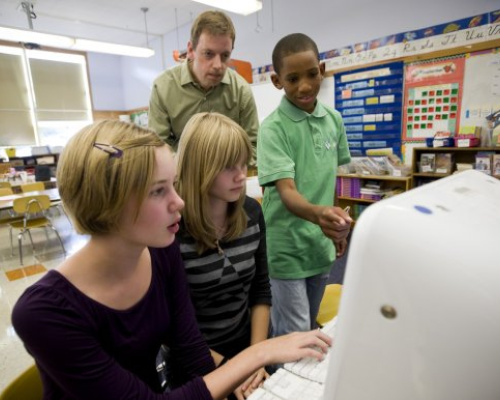Hi-Tech, Mid-Tech, Low-Tech: The Personalized 21st Century Classroom
Date
Although the idea of personalized learning has been around for a long time, the availability of technology has made it more practical for today’s classrooms. Teachers who have been working in traditionally teacher-centered environments are now thinking about how technology can make their classrooms more personalized, leading to more engaged students and improved academic achievement.
But all technology environments aren’t created equal. In some schools, all the students have a laptop or tablet they can take home at night. Other schools have 1:1 programs, but kids can’t take them home. Other schools have BYOD programs, stationary or mobile computer labs, or just a few desktop computers in the classroom. The good news is whether your classroom is hi-tech or minimalist tech, you can still use technology to personalize your students’ learning.
Let’s start with a simplified definition of personalized learning. From the teacher’s perspective, it means designing learning experiences that provide student choice and student ownership in order to enhance engagement and student learning.
That all sounds well and good, but what does it mean in the day-to-day process of teaching and learning?
Well, it doesn’t mean that students can study whatever they want or do whatever they feel like. A personalized classroom focuses on standards, just like a traditional classroom. But how students meet those standards is very different. And technology can play a big role in that difference.
Personalization and Student Choice
Fortunately, today’s Common Core State Standards for English Language Arts and Mathematics and the Next Generation Science Standards leave much more room for personalization than previous standards because they are conceptual rather than lists of topics to be “covered.” For example, the word “dinosaur” doesn’t appear in the NGSS and no specific work of literature is mentioned in the CCSSELA.
This opens up the possibilities for learning by allowing students to choose what aspect of a concept they want to study and how they will demonstrate what they have learned. All students can get basic information in the same way, through traditional means or models such as mobile or blended learning. Students can then add to the basics with topics and skills that interest them. Technology can be a big help as a research tool as well as a production tool where students use online tools and apps to learn and to show their learning.
But how can teachers in a less comprehensive technology program take advantage of technology’s benefits. Even in a personalized classroom, every activity is not individualized for each student. Students are often all doing the same thing, albeit, sometimes in different ways. Thoughtful classroom management can allow students to share the use of the available technology while still participating in whole-class activities.
I also suggest that teachers of upper elementary and secondary grades can learn something from primary teachers. Namely, the idea of “centers. In early grades, students often move in small groups to different areas in the room to accomplish different tasks. This strategy keeps learning interesting, encourages small-group interaction, and allows all students to participate in a variety of activities. In a classroom with just a few computers, activities could be organized so that one center, or more, if possible, has computer access, while others involve hands-on activities, individual reading or writing, or small-group discussions.
This kind of class arrangement, however, highlights the importance of the second critical aspect of a personalized classroom—student ownership.
Personalization and Student Ownership
Giving students choices about what and how they learn as well as how they show what they have learned does give students a feeling of ownership, but that is only half of the equation. They also need to be responsible for their own learning. To thrive in personalized learning environment students need to be self-directed learners.
An important strategy for helping students learn to manage their own learning is direct instruction and modeling in skills, such as collaboration, communication, goal setting, and reflection. Technology can play an important role in this aspect of personalized learning with the myriad of productivity tools and apps . Students, in fact, may be more proficient at using these tools to communicate and keep track of their work than their teachers are since their devices are so integrated into their daily lives.
Most productivity apps, like reminders, online calendars, to-to lists, and the like, are available online as well as in mobile apps. Students in a classroom with just a few computers can check in with these tools in just a few seconds. Some apps even allow teachers to use them to monitor students’ progress.
Another way that technology can foster student independence is by providing a concrete, accessible record of what they have done and thought. Setting goals and reflecting on learning are important metacognitive skills, critical for learning. Technology can record both the processes and products of learning, allowing students, and teachers, to reflect on their progress with concrete evidence. This can be a powerful tool for managing their learning.
So, a personalized learning classroom environment is within the reach of any teacher, regardless of the level of technology. Whether you take small steps toward personalization by just expanding a few learning activities to offer more choices or whether you focus on helping students take responsibility for their own learning in incremental steps, all students can have experiences that meet their individual needs and goals.
Learn more about personalized learning at the following sites:

